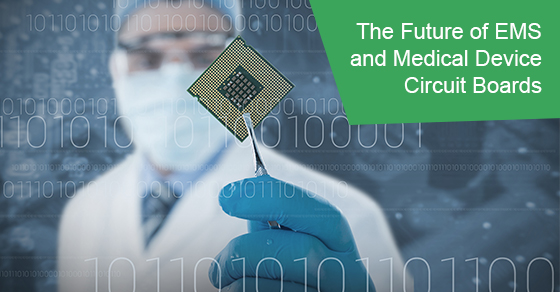The Future of EMS and Medical Device Circuit Boards
The medical equipment and medical industry have undergone rapid paradigm shifts in recent years. Consumer needs have shifted, and so too have the goals of the companies that manufacture medical equipment. These changes have spread to the PCB (printed circuit boards) assembly industry, as increased usability and functionality have come to the forefront.
Therefore, the future of healthcare will focus on updated and improved equipment to better serve the needs of an ageing population. Products will need to be easy to understand so that the elderly can use them without issue.
Here, we will discuss medical equipment manufacturers and the future of electronics manufacturing services (EMS) and medical device circuit boards.
Increased Patient Independence
Increased patient autonomy will be a top priority, as far as medical equipment manufacturers are concerned. For example, many of today’s monitoring systems have become integrated into smartphones, tablets, and iPads. The result is increased portability, as well as improved monitoring and recording functionality.
All a patient needs to do today is make a simple click on their smart-enabled device. With it, they will be able to directly contact their physician or surgeon to get advice or obtain an accurate diagnosis. Doctors can even check in on their patients in real-time using interactive tablets, whereas such duties were relegated to conventional nurses in the past.
The Benefits of Surface Mount Technology
Surface mount technology is arguably one of the best PCB assembly processes in the industry. It does not, for instance, include protruding leads for fitting purposes. The components are fitted with ease onto printed circuit boards. The components, soldering units, and set of equipment used are also completely different to maximize the technology's benefits.
Some of the benefits of surface mount technology include augmented efficiency and density, dynamic use, and easier automation. Surface mount technology is also more affordable than many of its alternatives, and requires less space than several of its counterparts.
Due to these aforementioned benefits, many North American medical equipment manufacturers have shifted to surface mount technology.
How does PCB assembly affect the medical industry?
Newfound innovations have led to an increased demand for medical devices that are futuristic and more functional than ever before. Automated diagnosis and monitoring have become the focus of many medical equipment manufacturers in the industry.
Medical printed circuit boards are currently used to manufacture many state-of-the-art pacemakers and MRI machines. Medical equipment circuit boards have also been used for several leading-edge monitoring devices, such as monitoring a patient’s body temperature.
Prototype printed circuit board assembly techniques are also currently being employed by many forward-thinking medical device companies. By doing so, the devices launched in the not too distant future will be ready to deal with new challenges.
Medical Devices that Utilize PCB Assembly and Manufacturing
Many medical implants currently use the printed circuit board manufacturing and assembly process. For example, cochlear implants—devices that help patients who are hard of hearing—use the PCB process. Defibrillator implants, which help people with heart problems, also use the PCB manufacturing and assembly process.
Additionally, responsive neuro-stimulators (RNSs) use the latest PCB assembly and manufacturing processes to save lives. RNSs help people who have epilepsy better manage their seizures and related symptoms.
Many monitoring devices have also integrated the latest PCB assembly and manufacturing technology to detect various anatomical aberrations and phenomena. For instance, most of the monitoring equipment that is manufactured today will integrate cutting-edge PCB technology to accurately monitor or gauge temperature, glucose, and pressure in patients.
Thousands of lives have been saved, as patients with hyper or hypothermia, type 1 diabetes, heart disease, and/or hypertension have been saved thanks to the latest advancements in medical implant and monitoring technology.
In regards to patient diagnostics, there have been recent advancements made in medical imaging devices. For instance, many of the latest imaging equipment use top-of-the-line circuit card assembly to work as intended. Examples include computerized axial tomography (CT), magnetic resonance imaging (MRI), and ultrasound devices.
Many patients who have epilepsy, MS, cancer, stroke, and several neurological disorders have been quickly and currently diagnosed due to these newfound advances. It is estimated that these innovative devices have saved millions of lives since they were first launched onto the market.
There is also other medical equipment that currently uses advanced printed circuit boards to function. Examples include EMG systems, heart monitors, infusion fluid control, and nerve stimulator units.
The End Goal of Modern PCB Assembly for Medical Equipment
Each PCB assembly method in medical equipment must have clearly defined purposes. It must have a specific audience and purpose and should include comprehensive solutions. Efficiency, accuracy, and functionality must also be resolute in providing optimized solutions for patients who already have enough to worry about.
Conventional medical devices are quite rigid. Fortunately, modern medical devices are flexible. Modern medical technology aims to cross such archaic barriers by creating superior products in smaller devices. By doing so, patients will enjoy more sophisticated technology in smaller casings, which will save space and allow for maximum comfort and mobility.
The Circuits Central Difference
If you would like to learn more about medical equipment manufacturers and the latest innovations in EMS and medical PCBs, please visit Circuits Central at our website. We have extensive experience in the medical sector, including manufacturing innovative chemical analysis, medical imaging, healthcare, monitoring, communication, and laboratory research equipment.
We can be reached at 1-888-821-7746 if you would like a free, no-obligation quote and consultation to discuss your medical PCB requirements with a member of our knowledgeable and dedicated team.

